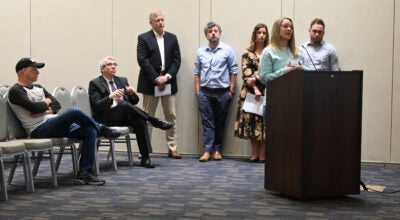Report: RSS budget in good shape
Published 12:00 am Wednesday, December 2, 2009
By Sarah Nagem
snagem@salisburypost.com
Despite high fuel prices and a significant jump in labor costs, the Rowan-Salisbury School System is in sound financial health, an analysis of the system’s budget shows.
After the school system sets aside a little more than $3 million in a “safety zone,” it will be left with about $2 million in funds that aren’t earmarked this school year, said Tara Trexler, the chief financial officer.
The Rowan-Salisbury Board of Education unanimously approved its budget at a meeting Monday night.
The board already knew schools were getting about $38.5 million in local money ó the bulk coming from Rowan County commissioners. But this budget includes updates with state and federal figures.
Rowan-Salisbury schools will get about $111.5 million from the state and about $11.4 million in federal funds, according to the budget.
The school system is playing it safe when it comes to diesel costs. The board set aside $270,000 in case the state falls short in shelling out money to gas up buses.
“We do not know if the state is going to cover all of our yellow bus fuel,” Trexler told the school board.
State fuel funding fell short during the 2007-2008 school year. The school system spent about $65,000 in local money for diesel fuel, school officials have said.
Thirsty buses aren’t the only thing causing a strain this year.
State lawmakers approved an average teacher-salary increase of 3 percent. Non-certified employees, like cafeteria workers, who make less than $40,000 are getting a raise of $1,100. Employees who make $40,000 or more are seeing a salary jump of 2.75 percent.
The system will spend a little more than $54 million in state money and another $8 million in local funds to pay teachers’ salaries.
State allotments are generally based on the number of students in a school system. The state is expecting only about 23 more students in the Rowan-Salisbury system this school year compared to last year.
The state funding numbers reflect a slight jump in enrollment in elementary grades and lower enrollment in high school grades.
State funding for teacher assistants, which is based on kindergarten through second-grade enrollments, will jump about 5 percent from last year, to almost $7 million.
Driver-education funds from the state, however, will drop about 3 percent. And the school system is losing money for one and a half career and technical education teachers.
The system also saw big decreases in state funding for technology and staff development.
Last year, the state doled out almost $889,000 for technology. This school year, the number is about $621,000.
Funding for staff development is dropping by almost $28,000.
These types of numbers reflect student enrollment, Superintendent Dr. Judy Grissom said.
“That’s because the state anticipated not much growth in our students,” she said of less funding.
This school year, the Rowan-Salisbury system will pay about $2.3 million toward its 1992 bond debt. It will use its anticipated $2.5 million in state lottery proceeds to pay on the 2002 bond debt.
Also during the meeting Monday:
– The school board gave West Rowan High School the go-ahead to host its graduation ceremonies on campus instead of at Catawba College.
Many parents have complained about the five-ticket limit per student at Catawba, said Jamie Durant, West’s principal.
The school will host its graduation ceremonies at the football stadium.
“I know we’re taking a chance on rain,” Durant said. “We will have alternate plans for that.”
If the weather is bad, the ceremony will be moved to the gym and cafeteria, he said.
– Board members discussed a revised wish list of the school system’s construction priorities.
Replacing Woodleaf Elementary and building a central office are on a priority list based on health and safety issues. Together, those projects would cost about $26.5 million.
A new Knox Middle School tops the regular priority list. Also present: a new Cleveland Elementary, a southwest area middle school, a south area elementary school, new classrooms at Koontz Elementary and high school and middle school gymnasiums.
Funds are not earmarked for any of these projects. But some school leaders will meet with a committee of county leaders Wednesday to talk about the need for a central office.





